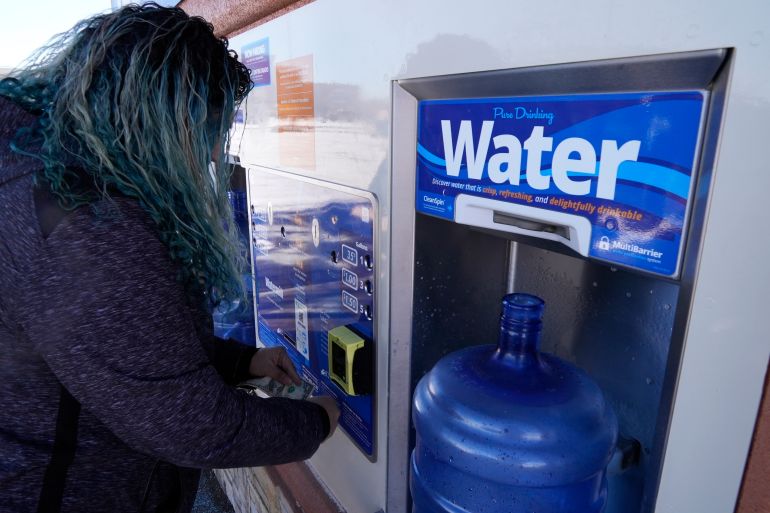US agency takes aim at ‘forever chemicals’ in drinking water
Environmental Protection Agency proposes first federal limits on ‘forever chemicals’, saying the move will save lives.

The United States Environmental Protection Agency has proposed the first federal limit on so-called “forever chemicals” in the country’s drinking water, a move officials said will save lives.
The proposal announced on Tuesday, which is subject to public comment before a final rule will be issued, will limit per- and polyfluoroalkyl substances, also known as PFAS.
Keep reading
list of 3 itemsHaitian appeal: Help us get clean drinking water
US tap water contaminated with ‘forever chemicals,’ report says
The substances have been linked to a range of health issues, including low birth weight and kidney cancer. They do not naturally degrade in the environment and are expensive to remove from water.
Radhika Fox, assistant EPA administrator for water, called the proposal a “transformational change”. The agency estimates the rule could reduce PFAS exposure for nearly 100 million Americans.
EPA is proposing the first-ever national standard to limit PFAS in drinking water. This action is a major step to protect communities from PFAS pollution, leveraging the latest science and building on existing state efforts to limit PFAS. pic.twitter.com/iBw91oL5Xh
— U.S. EPA (@EPA) March 14, 2023
“The science is clear that long-term exposure to PFAS is linked to significant health risks,” Fox said.
In a statement, the White House said, “PFAS pollution disproportionately affects disadvantaged communities and poses a serious threat across rural, suburban and urban areas.”
Environmental and public health advocates have called for federal regulation of PFAS chemicals for years.
But while the EPA has repeatedly strengthened its voluntary health thresholds for the chemicals, it had not previously imposed mandatory limits on water providers.
Meanwhile, only a handful of states have issued PFAS regulations, and none have set limits as strict as what the EPA is proposing, which experts say are the tightest possible standards that are technically feasible.
PFAS compounds have been used since the 1940s in industry and consumer products, including in nonstick pans, food packaging and firefighting foam. Their use is now mostly phased out in the US, but some still remain.
The proposal would set limits of four parts per trillion, the lowest level that can be reliably measured, for two common types of PFAS compounds: perfluorooctanoic acid and perfluorooctanoicsulfonic acid, called PFOA and PFOS, respectively.
In addition, the EPA wants to regulate the combined amount of four other types of PFAS.
The Association of State Drinking Water Administrators called the proposal “a step in the right direction”, but noted compliance will be challenging.
Despite available federal money, “significant rate increases will be required for most of the systems” that must remove PFAS, the group said on Tuesday.
The proposal would also regulate other types of PFAS like GenX chemicals, which manufacturers used as substitutes when PFOA and PFOS were phased out of consumer products. The proposal would regulate the cumulative health threat of those compounds and mandate treatment if that threat is too high.
"@EPA’s proposed limits on #PFAS chemicals in drinking water will prevent serious illness and death. We urge EPA to be equally decisive in holding polluters accountable for contaminated drinking water all over the country."
Read our full statement:https://t.co/jGxSgbuooH
— Clean Water Action (@cleanh2oaction) March 14, 2023
In a statement, the president of the environmental group Clean Water Action, Robert Wendelgass, said the EPA proposal “will prevent serious illness and death”.
However, he urged the agency to be “equally decisive in holding polluters accountable for contaminated drinking water all over the country and in curtailing the many thousand PFAS chemicals in everyday use”.
Others questioned the proposal, with Sri Vedachalam, director of water equity and climate resilience at Environmental Consulting & Technology Inc, telling the Associated Press that the rule would unfairly target utility providers.
“This is a problem that has been handed over to utilities through no fault of their own,” he said, adding that communities will need to balance the new PFAS requirements with other public health concerns, like removing poisonous lead pipes and replacing aged water mains prone to rupturing.
The EPA recently made $2bn available to states to get rid of contaminants such as PFAS and will release billions more in coming years.
The agency also is providing technical support to smaller communities that will soon be forced to install treatment systems, and there is funding in the 2021 infrastructure law for water system upgrades.